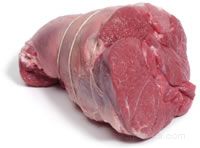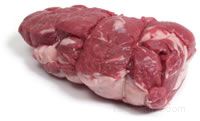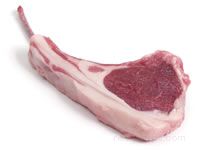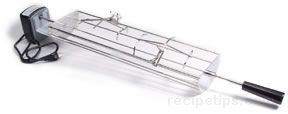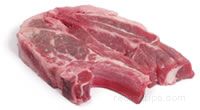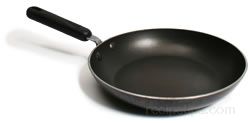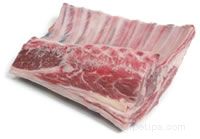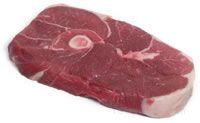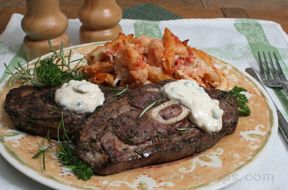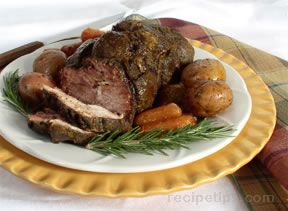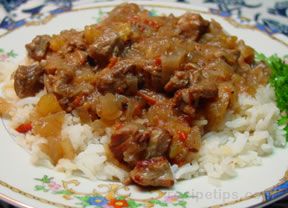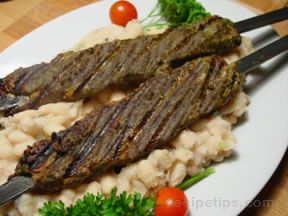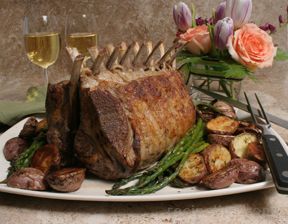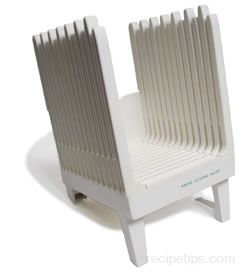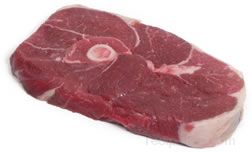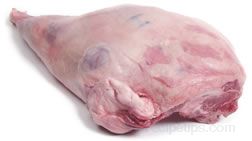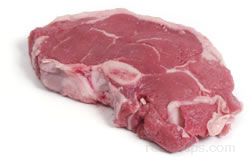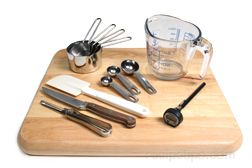Thawing | Preparing a Rack of Lamb | Preparing a Crown Roast
Preparing a Guard of Honor | Boning and Butterflying a Leg of Lamb | Grinding
|
Lamb that has been frozen should never be defrosted at room temperature because harmful bacteria may grow rapidly under such conditions. The best method for thawing lamb (or any other type of meat) is to place it in the refrigerator where it will defrost slowly and safely. A temperature range of 33ºF and 40ºF is ideal. A large cut of lamb may require 24 to 48 hours to defrost in the refrigerator. The meat should be placed on a plate or dish (to catch any juices that may drip from the thawing meat) and stored on the lowest shelf of the refrigerator. If it is not practical to wait the required time for thawing lamb in the refrigerator, it is possible to defrost the meat in the microwave using the proper defrost setting, but this is definitely not recommended. Some microwave ovens may not defrost the meat evenly, which may allow some portions to become fully thawed while other areas may still be frozen. While waiting for the frozen areas to defrost, harmful bacteria may grow rapidly in the thawed areas of the meat. It is best to use small cuts or pieces of lamb, which are safer to defrost with this method than large lamb cuts. Never use a normal cooking setting to defrost the meat. Lamb cuts should be cooked promptly after defrosting in the microwave and ground lamb must be cooked immediately after thawing. Microwave defrosting should be used only if necessary and should not be the thawing method of choice. |
|
Note the following points:
|
| A whole rib roast, or "rack of lamb" has seven or eight ribs. Although it may be cooked as is, it may also be "Frenched," which means that the upper ends of the rib bones are trimmed (and often capped with decorative covers known as frills) creating one of the most distinctive cuts from the lamb carcass. One rack of lamb is usually large enough to serve three people. |
| Begin preparing the rack of lamb by making a cut on the fat side, perpendicular to the ribs, about 2 inches down from the rib ends. Cut through the fat down to the rib bones. |  |
|
Turn the rack on end and push a knife through the flesh between each rib, using the initial cut as a guide for the knife. Turn the rack so that the fat side is down and score the thin membrane covering the rib bones using a sharp knife. |
 |
| Working from the fat side of the rack, push on the ends of the rib bones until they pop through the thin membrane. | 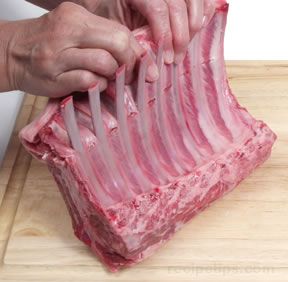 |
| After all of the bones have broken through the membrane, simply cut away the strip of meat from the rib ends. | 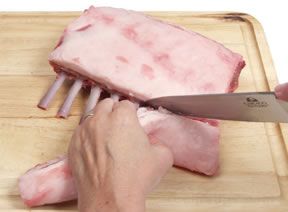 |
| The final step is to trim away some of the excess fat, leaving only a thin layer. | 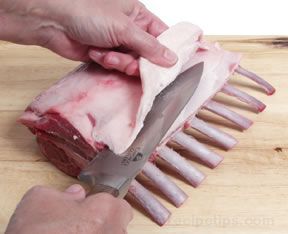 |
| The rack of lamb is ready for seasoning and roasting. |  |
| Two or three racks of lamb can be combined end to end and then curved into a circle to make a "Crown Roast". This is a special preparation of rack of lamb and may be available from some butchers without special ordering or the home cook can create it. |
| You will need at least two rib racks to create the crown roast. Use three racks to give the crown roast a rounder shape and to provide more servings. | 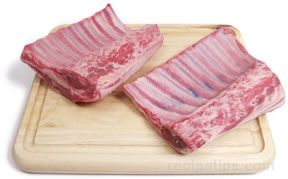 |
| After completing the steps in "Preparing a Rack of Lamb", perform the following simple steps to create the crown roast. |
| Make a shallow cut in the flesh between each rib bone so that the rib racks will curve easily into the proper shape. |  |
| Bend each rack into a semicircle (meat side out and fat side in) and tie them together at the base, center, and top to hold the racks together. The rib ends should be pushed outward to create the look of a crown. | 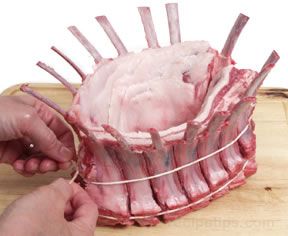 |
| The finished preparation may be roasted as is, however many cooks prefer to place stuffing in the cavity. |  |
| As an option, gold colored frills or aluminum foil are often placed onto the ends of the rib bones to prevent the bones from scorching and to add a decorative touch. | 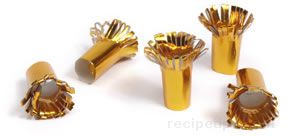 |
| Note: Be sure the chine bone (the remaining section of the back bone) has been removed before attempting to create the crown roast. |
|
A "Guard of Honor" is simply two racks of lamb that have been frenched, with the rib ends interlocked to resemble soldiers' swords. This is another special preparation of rack of lamb that may require an advanced order from a butcher or the home cook can easily create it. Begin the guard of honor by completing the steps in "Preparing a Rack of Lamb" and then perform the following steps. |
| Push two racks together to interlock the rib ends. |  |
| Tie the racks between every second or third rib to secure the racks together. |  |
| The guard of honor is fairly easy to prepare and makes an impressive dish for a special occasion. |  |
Boning and Butterflying a Leg of Lamb
| Only a few steps are required for boning and butterflying a leg of lamb, which makes it a relatively easy task for the home cook, however most butchers will do this for consumers who are not comfortable with attempting this at home. | 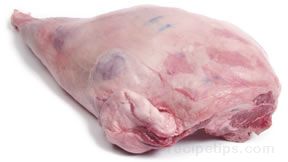 | |
|
Boning a Leg of Lamb
| ||
|
| ||
|
|
|
| Rolled and Tied Sirloin Roast | Rolled and Tied Shank Roast |
Butterflying a Boned Leg of Lamb
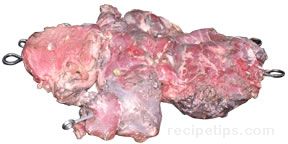
|
|
Ground lamb may be purchased from the butcher or food store or it can be prepared at home. You can purchase whole lamb cuts of your choice and grind it yourself, however the lamb should not be ground until you are ready to use it because ground meat deteriorates in quality rather quickly. Before the meat is ground, the fat and tendons should be removed. Several methods for producing ground lamb at home are described below. Meat Grinder A manual grinder can be used to grind meat as coarse or fine as you require. This method produces the most evenly ground meat. Some electric mixers also have attachments for grinding meat. |
|
Food Processor Chopping or grinding fresh lamb cuts is made easy with a food processor. Use the following steps for grinding lamb with this convenient tool:
|
|
Manual Chopping With the use of a sharp knife, lamb can be cut into cubes. It can then be cut into smaller pieces until the meat is the consistency that is desired. Manual chopping will provide firmer ground meat than any of the machine methods. |





